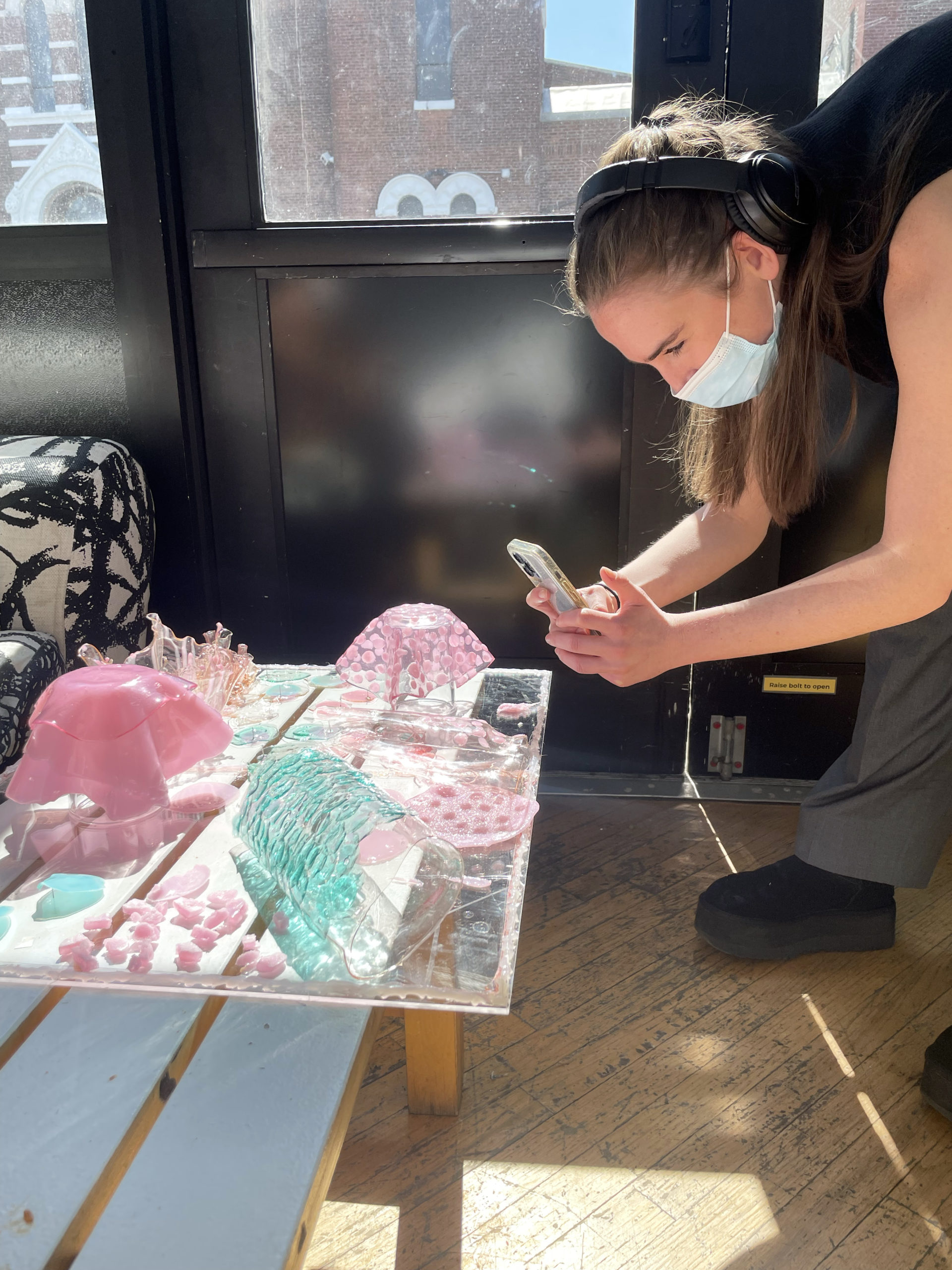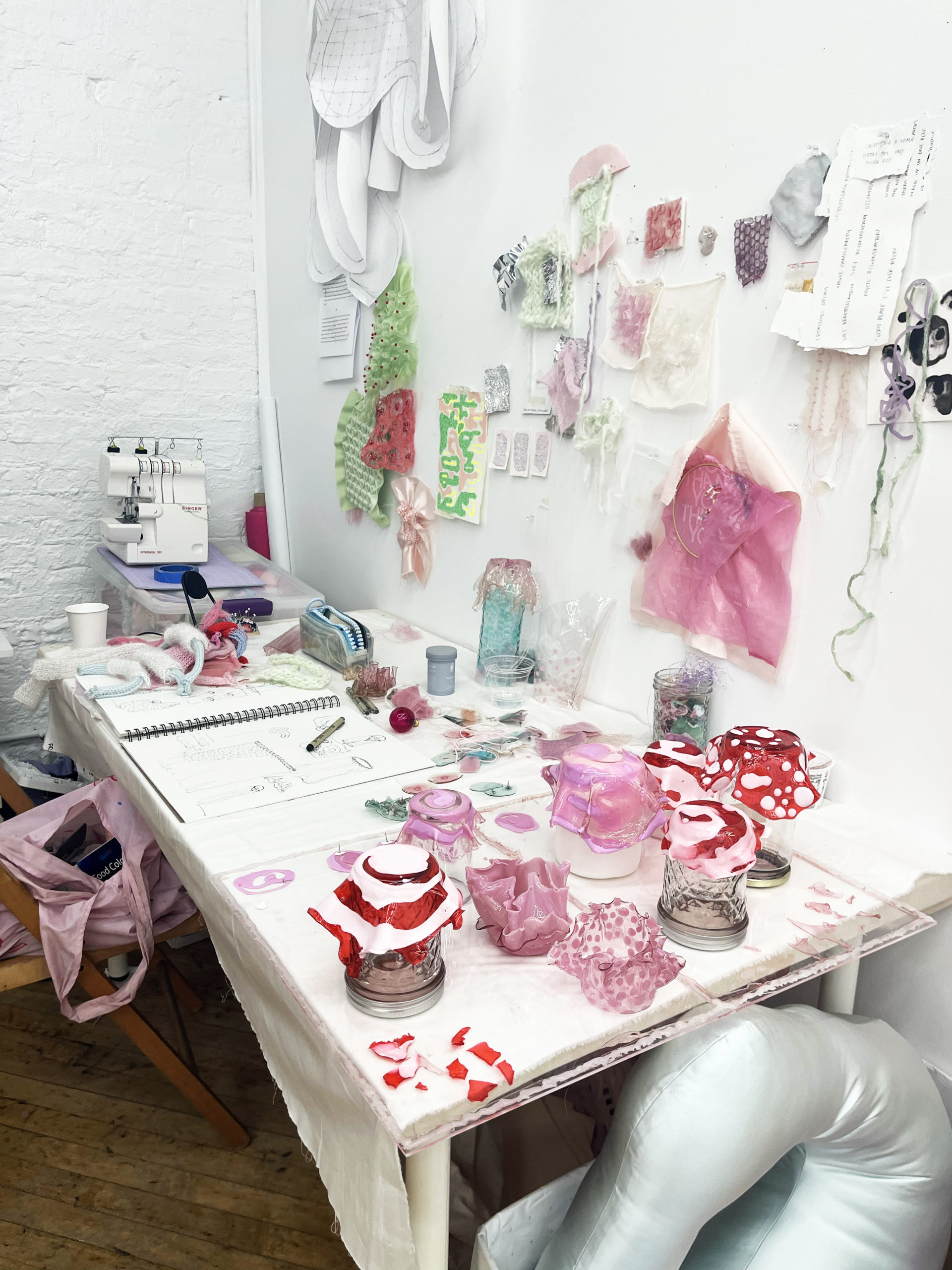Exploring Human Connection and Liminality using Bioplastics with Kat Sours
Upon initial encounter, the work of Kat Sours’ seems generally pleasing and quiet, especially as most of her pieces are soft pink toned and fragile in their glass-like appearance. After further investigation, the glass-like objects reveal themselves to be sturdy bioplastic, engineered through organic community recipes in Sours’ home and the Textile Arts Center dye lab.
An unexpected question that Kat Sours introduces in her bioplastic artwork is, “if you peeled back your skin, what would it look like? What would it feel like?” These are questions that reflect the grotesque and surreal nature captured in the otherwise comforting colors of Sours’ art. The bioplastic sculptures transform into intimate reflections of the inside of the body. The intimacy of knowing the inside of the body is something that Sours emulates in her artwork as she searches for human connection through the experience of touch. Sours’ work demands an emotional connection from her viewers through her use of nontraditional materials, specifically the creation of bioplastic sculpture. Sours explained that she creates tactile art with the desire to forge emotional bonds, as she counters the plague of loneliness in this digital age and downturning economy. Societal isolation and a general struggle to connect with her peers drives Sours to create work that confronts these shared experiences that people tend to dismiss despite their prevalence.

Sours’ current body of work can be described as tactile art, in that she invites her viewers to interact with her sculptures in order to invoke responses through the use of texture. This thinking was inspired by Sours’ childhood fascination with certain textures and an interest in the work of post minimalist Eva Hesse, who is known for pioneering industrial materials such as latex in art. Sours also uses her art to explore textures that were once uncomfortable to her such as that of living molds and wounds.
Sours’ originally graduated college with a fascination for fiber and fashion design but has since been exploring material science since being a resident at the Textile Arts Center. For Sours, there is no divide between her art made before discovering bioplastic materials and now but rather she views all of her work as able to coexist together in their exploration of human interaction. Sours’ choice of materials is inspired by her view of liminality in both her current period of life and the bioplastics she engineers. Sours identifies liminality as an in-between space in which the objects she creates are both real and imagined: she describes them as having “dream-like” qualities. The artist describes bioplastic as a “living” material that is shaped by its environment; the material is not necessarily made to last and Sours argues that this is a positive feature, as the art has a life of its own that will exist and die with its human audience. This take is not a political one though, as Sours explains that her work is not meant to provoke specific responses or function as a call to action about sustainability, but to encourage the audience to have an emotional experience through the empathetic space that comes with experiencing these made objects. The colors that are often depicted in Sours’ work are gentle pinks and blues, which disarm her audience and in turn create empathetic space for honest discussion. She credits the shades of red she often uses as the “colors of life,” which are usually found on the body. Recently, Sours has been exploring the use of natural dyes such as cochineal in her bioplastic creation to mimic bright synthetic pinks.
The term, “bioplastic” is not necessarily a familiar one in the art world and Sours’ initial draw to it came through the inability to understand and access it. Sours explained that there are various recipes online but few of them are accurate enough to create substantial usable material. It took many trials and errors to come up with the gelatin based plastic material Sours uses today. Even so, the artist continues to play with the recipes she finds to create new textures. Sours’ goal is to prevent future gatekeeping of these bioplastic recipes so that other people may have their own safe “play periods” that she originally did not have at the start of her journey with bioplastic creation. Sours joked about how she was once worried that she was “creating poison” in her home without proper ventilation space before she discovered the safer alternative of working with bioplastic instead of latex and rubbers like the materials of Eva Hesse. At the moment, Sours is working on creating a newsletter through her website of bioplastic recipes she uses herself that can be replicated using ordinary kitchen ingredients. She also credits the New York lab, “GenSpace '' for creating a space where ordinary people can come together to learn science processes; Sours has participated in many classes with GenSpace in her quest for the perfect bioplastics recipe.
Along with the creation of a bioplastics and material science newsletter, Kat Sours has an interest in bookmaking using the bioplastic materials she has created. Sours plans to further explore new materials that can be made from natural materials with newfound interest in sustainability. The exploration of forging human connections still remains in the work she makes and will probably continue to be the driving force behind why she creates artwork at all. Through her time as an artist in residence at the Textile Arts Center, Sours celebrates the community she can bounce ideas off of and the introduction of a true rhythmic discipline in her artmaking practice.
Follow Kat @katsours on instagram & Website: https://www.katsours.co/
